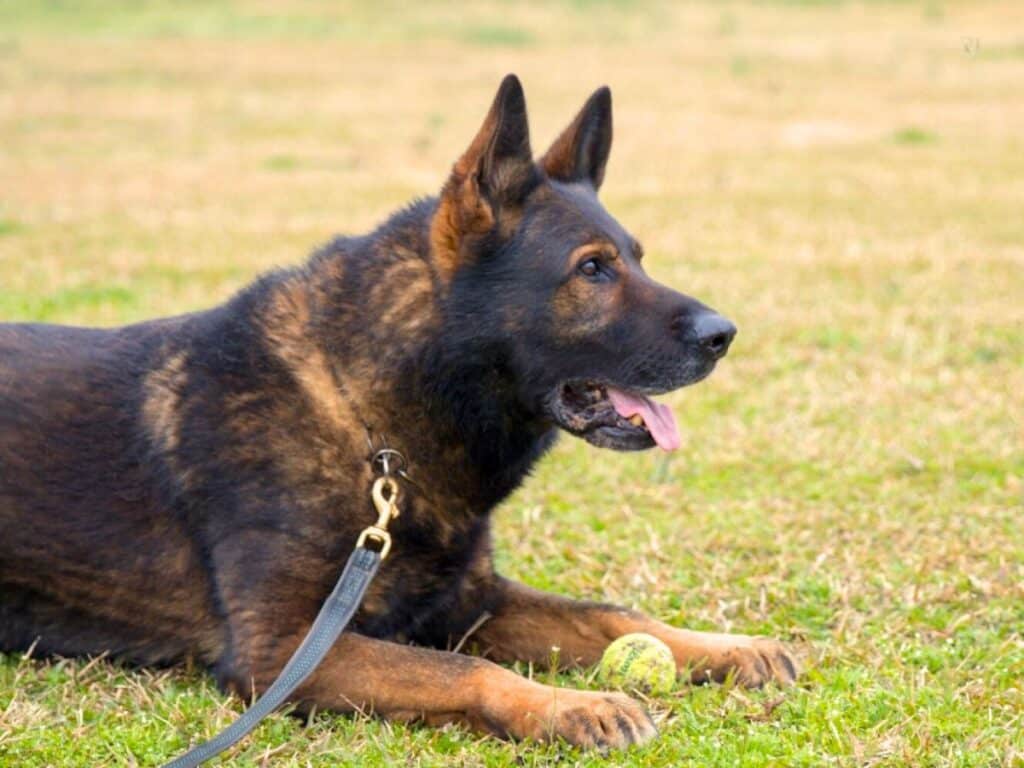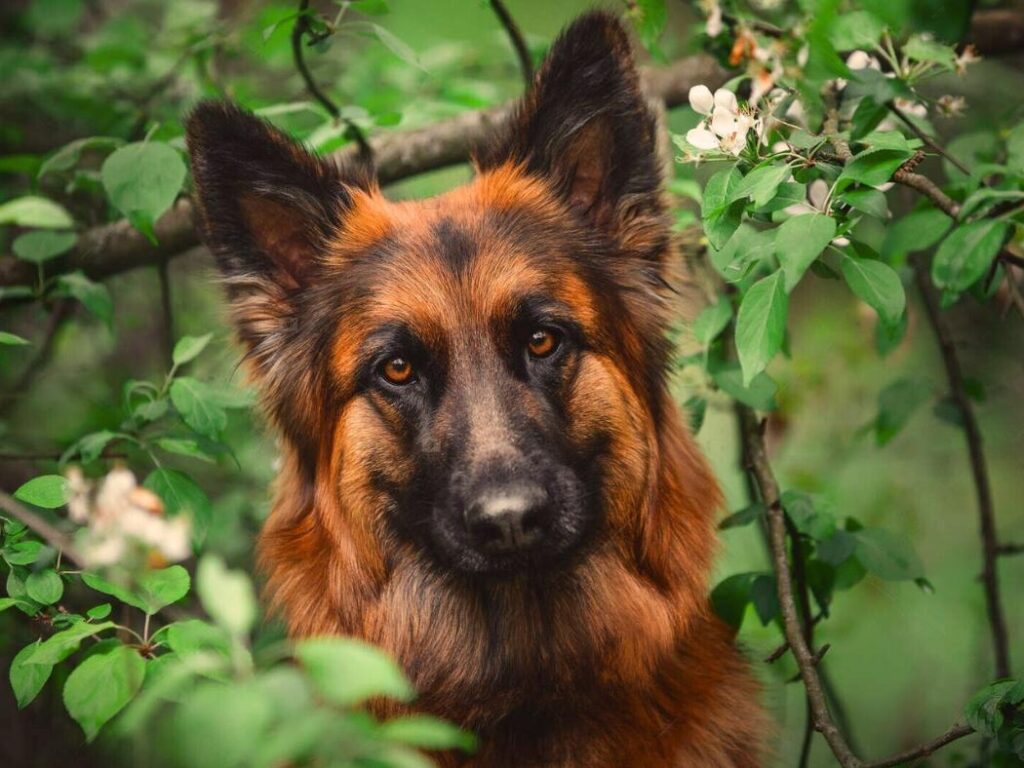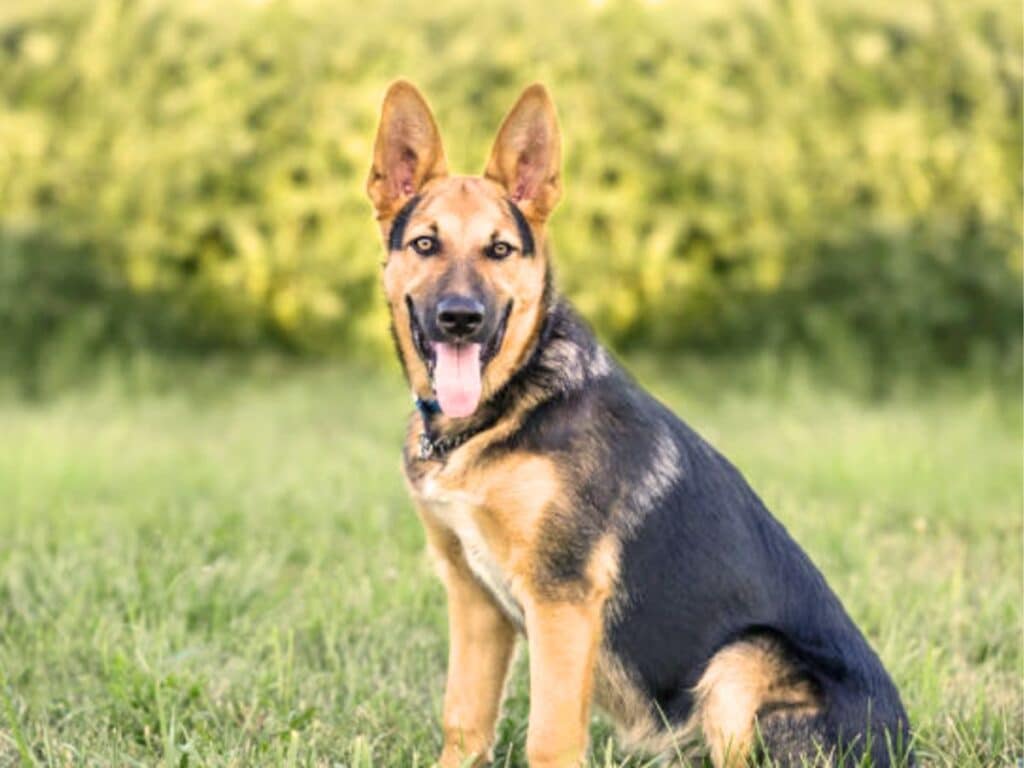Panda German Shepherds are a variation within the German Shepherd breed, characterized by distinct black/tan/red markings around the eyes and on the body, resembling the appearance of a panda.
Apart from their coat color, Panda German Shepherds exhibit similar characteristics in terms of size, personality, temperament, and overall health when compared to their standard-colored counterparts.
While this coat coloration is not officially acknowledged by major kennel clubs, it has gained popularity among enthusiasts as a unique and visually striking trait.
So in this article, we will cover everything there is to know about the dogs of this rare GSD color and help you decide if a panda German Shepherd is the right dog for you.

Panda German Shepherd Overview
| Characteristic | Panda German Shepherd |
|---|---|
| Weight | Male: 65-90 pounds (30-41 kg); Female: 50-70 pounds (23-32 kg) |
| Height | Male: 24-26 inches (61-66 cm); Female: 22-24 inches (56-61 cm) |
| Life Expectancy | 9-13 years |
| Coat Type | Double coat with a dense, outer coat and a softer undercoat |
| Coat Colors | 35% white with black, tan, or red markings throughout the body |
| AKC Recognized | No |
| Temperament | Intelligent, loyal, confident, courageous, and versatile |
| Trainability | Very high; excels in obedience training and various tasks |
| Exercise Needs | High; requires regular exercise and mental stimulation |
| Grooming Needs | Moderate; regular brushing, especially during shedding seasons |
| Health Issues | Prone to hip and elbow dysplasia, as well as certain genetic conditions |
| Common Jobs | Police and military work, search and rescue, guide dogs, and as family pets |
| Notable Features | Pointed ears, alert expression, strong and athletic build |
| Socialization | Early socialization is crucial; tends to be protective and may be reserved with strangers |
| Energy Level | High energy; benefits from regular physical and mental activities |
| Loyalty | Extremely loyal to their family; can form strong bonds with their owners |
| Shedding | Sheds heavily, especially during seasonal changes; regular grooming helps manage shedding |
| Vocalization | Can be moderately vocal and may bark to alert or express excitement |
| Agility | Agile and known for their versatility in various dog sports |
| Protective Instinct | Natural protectors; make excellent guard dogs |
| Adaptability | Adaptable to various living environments, but thrive with an active lifestyle |
| Rarity | One of the rarest colors of the German Shepherd breed |
| Price | $1000-$3000 or more |

What Does a Panda German Shepherd Look Like?
The primary characteristic of Panda GSDs is their coat coloration. A panda German Shepherd is typically 35% white, mostly on the forehead, muzzle, chest, collar, belly, and tip of the tail, while the remainder of the coloring i.e. black and/or tan and/or red is spread throughout the body,
Their face usually has a black mask, which further contributes to their panda-like appearance. Some German Shepherds with a panda pattern can also develop ticking in their white markings.
Some GSDs with panda patterns can have blue eyes and very rarely some pink on their noses.
Size & Weight
In terms of size and body structure, Panda GSDs closely resemble standard German Shepherds.
Males typically stand between 24 and 26 inches (61-66 cm) tall at the shoulder and weigh between 65 and 90 pounds (29-41 kg). Females are slightly smaller, standing between 22 and 24 inches (56-61 cm) tall at the shoulder and weighing between 50 and 75 pounds (23-34 kg).
They are a medium to large-sized breed with a well-muscled and robust build. They have a strong and agile physique, reflecting their working dog heritage.
Their body proportions are typically well-balanced, with a deep chest, straight back, and strong, slightly sloping hindquarters.

What Makes a Panda German Shepherd?
The unique appearance of panda-like markings seen on Panda German Shepherds can be attributed to a specific gene known as the “KIT” gene.
Just like in pandas, the KIT gene affects pigmentation distribution in the fur, resulting in patches of black on an otherwise predominantly white coat.
Scientists have discovered that a mutation in the KIT gene alters how pigments are distributed during embryonic development, leading to the striking black-and-white pattern we associate with pandas.
The first known panda GSD named Lewcinka’s Franka von Phenom or Franka was born in the year 2000 to a purebred black German Shepherd dam and a purebred black and tan German Shepherd sire.
Franka’s panda pattern was scientifically tested and was attributed to a spontaneous mutation in one of her sire’s reproductive cells
The rest of the puppies in the litter were standard black and tan German Shepherd puppies.

Panda German Shepherd Temperament
Despite their unique appearance, Panda German Shepherds share the same temperament as their standard-colored counterparts.
They are loyal, intelligent, and obedient. They form deep bonds with their families and enjoy spending quality time with their loved ones.
These dogs thrive on human companionship and appreciate being involved in family activities.
Their affectionate nature also extends towards children when properly socialized and supervised.

Highly Intelligent & Trainable
They are incredibly intelligent dogs that can quickly grasp new concepts and commands. These dogs have an innate desire to please their owners, making training sessions a breeze.
These dogs have a natural protective instinct that makes them excellent guard dogs for families.
When properly socialized from an early age, these dogs can easily differentiate between real threats and harmless situations.
Socialization and Training are Crucial
To ensure that these dogs develop into well-rounded individuals, early socialization is key.
Introducing them to various people, animals, and environments from a young age helps them become more comfortable and confident in different situations.
Proper training is equally important in shaping their behavior. Consistency, positive reinforcement, and clear communication are essential elements when training these intelligent dogs.

Regular Exercise & Playtime
Just like their standard counterparts, Panda German Shepherds are active and highly energetic. An adult panda GSD needs at least 1-2 hours of daily exercise and playtime.
Regular walks, playtime with interactive toys, and obedience training sessions are key components of their exercise routine. Incorporating activities like agility training, running, or hiking, considering the breed’s energetic nature, can provide additional stimulation.
Engaging in fetch games and ensuring socialization with other dogs and people contribute to a well-rounded exercise regimen.
It’s crucial to tailor the activities to the individual dog’s age, health, and preferences while being consistent in meeting their energy levels.

Panda German Shepherd Health Issues
Panda German Shepherds are as healthy as any other color German Shepherds. The panda gene does not affect a dog’s health in any way.
Moreover, they don’t seem to have the same pigment-related congenital deafness risk caused by the piebald gene as dogs with other white spotting patterns.
However, Panda GSDs do share the same health issues as the broader German Shepherd breed.
These can include:
- Hip Dysplasia: A hereditary condition where the thighbone doesn’t fit snugly into the hip joint. This can lead to arthritis over time.
- Elbow Dysplasia: Similar to hip dysplasia, this is a malformation of the elbow joint often caused by a genetic predisposition.
- Degenerative Myelopathy (DM): A progressive disease of the spinal cord that affects the hind limbs. It is more common in older German Shepherds.
- Exocrine Pancreatic Insufficiency (EPI): A condition where the pancreas doesn’t produce enough enzymes to properly digest food.
- Bloat (Gastric Torsion): A life-threatening condition where the stomach fills with air and twists. This can happen more frequently in deep-chested breeds like the German Shepherd.
- Allergies: German Shepherds can be prone to allergies, including food allergies and environmental allergies.
- Epilepsy: Some German Shepherds may be prone to seizures, which can be managed with medication.
German Shepherd owners need to work closely with a veterinarian to monitor their dog’s health and address any concerns promptly.
Check out this cute video of a Panda German Shepherd called Nova…

Frequently Asked Questions
Are Panda German Shepherds Rare?
Yes, Panda German Shepherds are considered relatively rare compared to traditional German Shepherds.
The panda-like coat pattern is not a naturally occurring variation in the German Shepherd breed but rather a result of specific breeding efforts.
Breeders selectively breed German Shepherds with certain genetic traits to produce the distinctive black-and-white coloration seen in Panda Shepherds.
Because the panda coat pattern is not recognized by major kennel clubs and breed organizations, most breeders avoid breeding them which also contributes to their rarity and limited availability.
Additionally, breeding for the panda coat pattern can be a challenging and complex process. It requires careful selection and pairing of dogs with the desired genetic traits to consistently produce offspring with the panda coloring.
As a result, finding a reputable breeder who specializes in Panda GSDs can be more difficult which adds to their rarity.

Are Panda German Shepherds Recognized by the AKC?
No, the American Kennel Club (AKC) does not recognize the Panda coloration as a standard or variation of the German Shepherd breed, and it is considered a fault in the show ring.
This means the Panda German Shepherds can not be shown in the AKC conformation events, however, they can participate in other AKC events such as agility trials, herding events & obedience trials.
But more importantly, they can still make wonderful companions and working dogs, possessing the same intelligence, loyalty, and versatility as their traditional counterparts.
Are Panda German Shepherds Purebred?
Yes, Panda German Shepherds are purebred. The first panda German Shepherd was born to a purebred dam and a purebred sire.
Panda GSDs are purebred German Shepherds that have a unique color variation due to a natural genetic mutation in the KIT gene, giving them their distinctive panda-like markings.

How Much Do Panda German Shepherds Cost?
The price of a Panda German Shepherd may typically range from $1,000 to $3,000 or more.
Reputable breeders who prioritize health and quality breeding practices tend to charge higher prices for their puppies.
But the most important factor that affects their price is demand. Panda Shepherds are relatively rare compared to traditional black and tan German Shepherds.
Their unique coat pattern resembling a panda makes them highly sought after by dog enthusiasts worldwide.
Due to this rarity and high demand, Panda Shepherds often come with a premium price tag.
How Do You Get a Panda German Shepherd?
Obtaining a Panda German Shepherd, given their rarity, typically involves careful research and a selective approach. Interested individuals can start by searching for reputable breeders who specialize in this specific coat variation within the German Shepherd breed.
Connecting with breeders who prioritize ethical practices, health, and responsible breeding is crucial. Additionally, potential owners may explore rescue organizations or breed-specific shelters that occasionally have Panda German Shepherds available for adoption.
If choosing a breeder, ensure they are responsible, ethical, and not breeding for color or charging inflated prices for “rare” variants.

What Happens if You Breed Two Panda German Shepherds?
If two Panda German Shepherds, each carrying one regular and one Panda gene, have puppies, there is a possibility that the puppies might end up with two Panda genes from their parents. Sadly, any puppy with two Panda genes will not be able to survive. Therefore, it is risky to breed two Panda German Shepherds together.
What is the Average Lifespan of Panda German Shepherds?
The average lifespan of a Panda German Shepherd ranges from 9 to 13 years. Providing proper care, including a balanced diet, regular exercise, mental stimulation, and routine veterinary care can contribute significantly to extending the lifespan of these dogs.
Ensuring they receive adequate nutrition tailored to their needs helps support overall health and longevity.

How Many German Shepherd Colors Are There?
There are 11 German Shepherd colors recognized by the AKC:
- Black
- Black & Cream
- Black & Red
- Black & Silver
- Black & Tan
- Gray
- Sable
- White
- Liver
- Blue
- Bi-Color
Also, there are German Shepherd coat colors that are not recognized by AKC:
- Panda
- Isabella/Lilac
- Red Sable
Closing Thoughts
In conclusion, acquiring and caring for a Panda German Shepherd requires a thoughtful approach that encompasses various aspects of their well-being. The breed’s renowned intelligence and versatility make them well-suited for obedience training and mental stimulation. Proper socialization contributes to a balanced temperament, and engaging in activities that align with their energetic nature can foster a fulfilling companionship. Prospective owners should prioritize reputable breeders who prioritize the health, temperament, and training needs of Panda German Shepherds, ultimately leading to a rewarding and harmonious relationship with these remarkable dogs.




